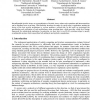3206 search results - page 55 / 642 » How minds can be computational systems |
EATCS
1998
14 years 9 months ago
1998
Experiments have shown [2] that we can only memorize images up to a certain complexity level, after which, instead of memorizing the image itself, we, sort of, memorize a probabil...
64
Voted
CDC
2008
IEEE
15 years 4 months ago
2008
IEEE
— We construct a family of iterative discretization algorithms for computing sequences of finitely-supported correlated equilibria of n-player games with polynomial utility func...
103
click to vote
FDL
2003
IEEE
15 years 3 months ago
2003
IEEE
Reconfigurable Systolic Arrays are a generalization of Systolic Arrays where node operations and interconnections can be redefined even at run time. This flexibility increases the...
ICEIS
2008
IEEE
15 years 4 months ago
2008
IEEE
— This paper investigates Grid computing from the point of view three basic computing platforms. The platform consists of virtual compute resources, a programming environment all...
HUC
2003
Springer
15 years 3 months ago
2003
Springer
Location is a primary cue in many context-aware computing systems, and is often represented as a global coordinate, room number, or a set of Euclidean distances to various landmark...


